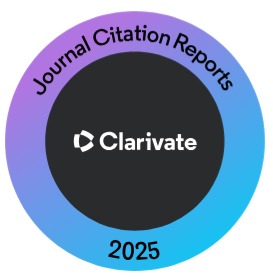Risk Factors, Site and Outcome of Intracranial Hemorrhage in Young Adults
Keywords:
Lobar, Arteriovenous malformation, Hypertension, Intracranial hemmorhageAbstract
Objective: To determine risk factors and the site and outcome of intracranial Hemorrhage in young adults.
Methodology: This cross-sectional observational study was conducted in neuromedicine ward 28 at Jinnah Postgraduate Medical center, Karachi, from September 2020 to August 2023. All emergency patients with evidence of Neuroimaging and symptomatic intracranial Hemorrhage were included. Using the Glasgow outcome scale, we investigated the risk factors, cause, location and prognosis of intracranial hemorrhage. Traumatic hemorrhages, primary sub-arachnoid hemorrhage and brain tumors were excluded.
Results: 72 patients aged 16 to 40 years were included. Forty were Male patients, 55%, and 32 were female patients, 45%. The risk factors for intracranial hemorrhages were hypertension 60/72 (83.33%), ArterioVenous malformation 7/ 72 (9.33%), Cryptogenic 2/72 (2.77%), drug-induced 1/72 (1.38%), hypocholesterolemia 1/72(1.38%) and tobacco and alcohol intake 1/72 (1.38%). In 36/72 (50%), the location was basal ganglia, 25/72(34.72%) was in lobar, 7/72 (9.72%) in Subarachnoid, and 4/72 (5.55%) in other locations. The outcome was favorable in 65/72 (90.27%) patients.
Conclusion: It has been found that hypertension, even in adults, is the leading risk factor for intracranial Hemorrhage below 40 years of age. Intracranial Hemorrhage is primarily present in the basal ganglia. AV malformation is the second most common risk factor in adults at our setup, and the outcome is good in adults. Drug, smoking, and hypocholesterolemia are less common causes of intracranial Hemorrhage in young adults.
References
Ruíz-Sandoval JL, Cantú C, Barinagarrementeria F. Intracerebral hemorrhage in young people: analysis of risk factors, location, causes, and prognosis. Stroke. 1999; 30(3): 537-41. doi: 10.1161/01.str.30.3.537.
Morotti A, Goldstein JN. Diagnosis and management of acute intracerebral Hemorrhage. Emerg Med Clin North AM. 2016; 34(4): 883-899. doi: 10.1016/j.emc.2016.06.010.
Ruiz-Sandoval JL, Romero-Vargas S, Chiquete E, Padilla-Martínez JJ, Villarreal-Careaga J, Cantú C, Arauz A et al. Hypertensive intracerebral hemorrhage in young people: previously unnoticed age-related clinical differences. Stroke. 2006; 37(12): 2946-50. doi: 10.1161/01.STR.0000248766.22741.4b. Epub 2006 Nov 9.
Huang WY, Saver JL, Wu YL, Lin CJ, Lee M, Ovbiagele B. Frequency of intracranial Hemorrhage with low-dose aspirin in individuals without symptomatic cardiovascular Disease: a systematic review and meta-analysis. JAMA Neurol. 2019; 76(8): 906-14. doi: 10.1001/jamaneurol.2019.1120.
Capodanno D, Angiolillo DJ. Aspirin for primary cardiovascular risk prevention and beyond in diabetes mellitus. Circulation. 2016; 134(20): 1579-94. doi: 10.1161/CIRCULATIONAHA.116.023164. Epub 2016 Oct 11.
Lei H, Gao Q, Liu SR, Xu J. The benefit and safety of aspirin for primary prevention of ischemic stroke: a meta-analysis of randomized trials. Front Pharmacol. 2016; 7: 440. doi: 10.3389/fphar.2016.00440.
Rajashekar D, Liang JW. Intracerebral Hemorrhage. In: StatPearls[Internet]. Treasure Island (FL): StatPearls Publishing; 2024 Jan.
Rigamonti D, Drayer BP, Johnson PC, Hadley MN, Zabramski J, Spetzler RF. The MRI appearance of cavernous malformations (angiomas). J Neurosurg. 1987; 67(4): 518-24. doi: 10.3171/jns.1987.67.4.0518.
Lee SU, Kim T, Kwon OK, Bang JS, Ban SP, Byoun HS, Oh CW. Trends in the incidence and treatment of cerebrovascular diseases in Korea: part I. Intracranial Aneurysm, Intracerebral Hemorrhage, and Arteriovenous Malformation. J Korean Neurosurg Soc. 2020; 63(1): 56-68. doi: 10.3340/jkns.2018.0179. Epub 2019 May 8.
Altschul D, Smith ML, Grant SP. Medscape [Internet]. 25 April 2022. Intracranial arteriovenous Malformation, Cavernous Angioma, Venous Angioma and Capillary Telangiectasia. Available from: https://emedicine.medscape.com/article/252426-overview.
Gaillard F, Baba Y, Bell D. Radiopaedia [Internet]. 19 Oct 2021. Cerebellum. Available from: https://radiopaedia.org/articles/cerebellum.
Jena M. Narayana Health [Internet]. 2 April 2020. Hypertensive Intracranial Hemorrhage. Available from: https://www.narayanahealth.org/blog/hypertensive-intracranial-haemorrhage/
Le NK, Kesayan T, Chang JY, Rose DZ. Cryptogenic intracranial hemorrhagic strokes associated with hypervitaminosis E and acutely elevated ?-tocopherol levels. J Stroke Cerebrovasc Dis. 2020; 29(5): 104747. doi: 10.1016/j.jstrokecerebrovasdis.2020.104747. Epub 2020 Mar 6.
Sharma R, Matsushita K, Wu A, Jack Jr CR, Griswold M, Mosley TH et al. Common medications and intracerebral Hemorrhage: The ARIC study. J Am Heart Assoc. 2021; 10(5): e014270. doi: 10.1161/JAHA.120.014270. Epub 2021 Feb 15.
Cho S, Rehni AK, Dave KR. Tobacco use: a major risk factor of intracerebral Hemorrhage. J Stroke. 2021; 23(1): 37-50. doi: 10.5853/jos.2020.04770. Epub 2021 Jan 31.
Hartmann A, Mast H, Mohr JP, Koennecke HC, Osipov A, Pile-Spellman J et al. Morbidity of intracranial Hemorrhage in patients with cerebral arteriovenous malformation. Stroke. 1998; 29(5): 931-4. doi: 10.1161/01.str.29.5.931.
Downloads
Published
How to Cite
Issue
Section
License
Copyright (c) 2024 Journal of Liaquat University of Medical & Health Sciences

This work is licensed under a Creative Commons Attribution-NonCommercial-ShareAlike 4.0 International License.
Submission of a manuscript to the journal implies that all authors have read and agreed to the content of the undertaking form or the Terms and Conditions.
When an article is accepted for publication, the author(s) retain the copyright and are required to grant the publisher the right of first publication and other non-exclusive publishing rights to JLUMHS.
Articles published in the Journal of Liaquat University of Medical & health sciences are open access articles under a Creative Commons Attribution-Noncommercial - Share Alike 4.0 License. This license permits use, distribution and reproduction in any medium; provided the original work is properly cited and initial publication in this journal. This is in accordance with the BOAI definition of open access. In addition to that users are allowed to remix, tweak and build upon the work non-commercially as long as appropriate credit is given and the new creations are licensed under the identical terms. Or, in certain cases it can be stated that all articles and content there in are published under creative commons license unless stated otherwise.























